“You’ve got to respect the place that you are diving. The Galapagos Islands are like nowhere else.”
So says Ruly Menoscal, the lead guide on my 10-day cruise aboard the Galapagos Master. And boy is he right — diving in the Galapagos is like an all-you-can-eat buffet of only your favorite dishes. There’s no throwaway coleslaw or potato salad here. On our trip, the closest we come to a so-so dive is our check-out in the harbor of San Cristobal, where there’s little coral and a sandy bottom without much to see — until two of the harbor’s resident sea lions join us in about 30 feet of water. After 20 minutes underwater, I’m hooked.
Only four of the 21 islands are inhabited, which leaves most of 3,093-square miles (8,000 square km) completely untouched. This makes for a raw, wild landscape and little to no run-off in the water. Even better, three ocean currents — the cold South Equatorial Current (the source is the Humboldt Current), the warm Panama Current, and the cold, deep Cromwell Current — converge in the Galapagos, creating arguably the world’s richest marine environment.
Now boarding the Galapagos Master
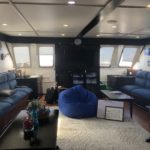
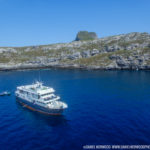
I meet the other divers for my cruise at the small, easily navigable airport in San Cristobal. There’s excited chatter in several languages on the bus to the harbor — there are Germans, Swiss, English, French and Canadian divers on board — in fact, I’m the only American. On our stroll down the pier, the sound and sight (though maybe not the smell) of at least 100 sea lions, lolling on the harbor rocks delights me. After a short ride out, we board the waiting boat.
There are 12 staff onboard, including our chef Angel, pretty much always my favorite crewmember. Our guides Raul (who goes by Ruly) and Jimmy have been on the boat for varying amounts of time. Guides here are freelancers, moving from boat to boat, working a few weeks on, a few weeks off. Each of ours has thousands of hours underwater in the islands though, so we’re in good hands. We take a quick look at the dive deck before heading inside the boat, first through the dining area and then past a large camera station, and finally into the salon, occupying the bow of the boat. Wide, comfortable looking blue banquettes and a few comfy-looking beanbag chairs beckon, but first it’s downstairs to check out my cabin.
There are four cabins on the lower deck and four on the upper deck, and mine is more than roomy enough. I’ve got no roommate, so I use the extra twin bed for storage and guiltlessly claim every hanger in the armoire. After unpacking — tip: bring more comfy clothes than you think you’ll need — we head upstairs for a short tour before the boat briefing. On the upper deck, occupying the aft of the boat, is a large, shaded seating area, with even more beanbags and comfy couches. Up one more level is the sun deck where I find — you guessed it — more beanbag chairs, a cocktail bar, and a fantastic 360-degree view. No time to enjoy it yet, though; first it’s time for the boat and dive briefings.
Each day except the first two will feature three or four dives; today we just had time for our checkout, and tomorrow we’ll dive once in the afternoon after an island walk. I’m equally excited for both and head downstairs early to get some sleep for what’s sure to be a full day.
North Seymour Island
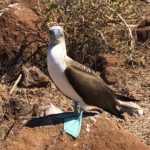
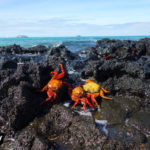
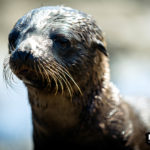
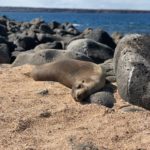
Divers on Galapagos liveaboards are allowed two visits to land: we use our first the next morning on North Seymour Island, a small, uninhabited spot that’s positively bursting with life. A few hours’ nature walk along a signposted route (leaving the path is not allowed) introduces us to iconic blue-footed boobies, nesting frigate birds, sunbathing iguanas and dozens of sea lions, from small pups to burly bulls.
Although there is some tree cover on North Seymour, the landscape of the islands themselves is generally stark. It’s all volcanic rock, with little tufts of greenery and patches of low trees. There are no big land mammals in the Galapagos; there’s simply not the environment to support them. But the animals here — and there are many — have thrived since the islands became a protected national park in 1959.
After completing the loop path and snapping dozens of pictures, we’re heading back to the boat for our first “real” dive. As we’re leaving, a few more groups of tourists arrive for walks of their own. One of them asks me if it’s worth it, to which I chuckle softly and reply, “Oh yes. Yes, it is.”
Diving in Galapagos
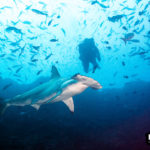
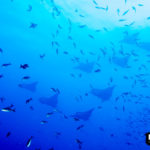
As Ruly said from the get-go, you’ve got to respect the place you’re diving. Marine life in Galapagos is spectacular, but you’ve got to earn it with potentially challenging conditions, so I follow the briefing closely, admittedly a little nervous about back-rolling with a negative entry into potentially strong current. On our trip, we’ll have up to 27 dives, including two full days each at Darwin and Wolf Islands, followed by days at Isabela, Fernandina, Cabo Marshall and Cousins Rock.
Although the boat can easily accommodate 16 divers, our group is small at 12, so we split into two groups of six. We dive via two pangas, taking turns going first; always at the same dive site but never crowded together.
We gear up and get ready for our first “official” dive in the Galapagos in the channel between tiny Mosquera Island and Baltra near North Seymour. After 50 minutes underwater, I’m filled with awe. We drop down on some sloping boulders that front a nice sandy patch and almost immediately there’s a small school of scalloped hammerheads along with a giant blacktip shark. There are countless turtles, giant schools of fish, eagle rays, scalloped hammerheads, the blacktip, turtles —sometimes all at the same time. We drift along with the boulders to our right and level up from 70 feet to about 50 where the current catches us. Up and over the boulders we go, flying along in about 12 feet of water on an extended safety stop.
Once we’re all back onboard, it’s time to begin the overnight journey to the legendary Darwin and Wolf Islands, where there’s simply too much to cover here. Stay tuned for another story focusing exclusively on these legendary dive sites.
Dive, dive, dive
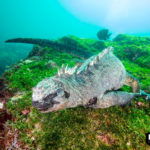
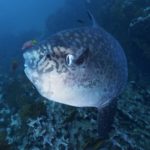
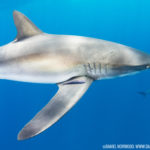
After four full days at Wolf and Darwin, we move on to our next site, Punta Vicente Roca, off the northwest coast of seahorse-shaped Isabela Island. It’s the largest in the island chain, formed by six active volcanoes. The site sits right on the seahorse’s lower jaw. Unfortunately, however, I’ve developed a cold overnight and can’t clear my ears for the dive, which will be relatively deep and involve a search for the site’s iconic residents — mola mola.
I’m gutted, but my panga driver Javier graciously putters me around the bay while the divers are down, looking for tell-tale signs of molas at the surface. We luck out and spot a few, so I slip as quietly as possible into the water to get a peek. I’m rewarded with brief glimpses of these famously shy fish before they disappear into the deep. Not to be outdone, the bay’s resident sea lions come to play with me on the surface as well. They dive-bomb and twist around me, matching their play with my own level of enthusiasm. For a non-dive day, I couldn’t be happier.
Next up is Cabo Douglas, home of another famous Galapagos resident: marine iguanas. These ingenious, endemic reptiles have figured out that the algae encrusting the boulders just offshore is a fantastic food source. Each day at mid-morning, after the sun has warmed the chilly water a bit, they slip beneath the surface to munch on the algae below. They grip the rocks with their strong claws, spending up to 40 minutes underwater to feed before coming up for a gulp of air and submerging again.
“It’s a 40-minute safety stop” says Ruly of the site, where divers will spend as long as they can in chilly water only 10 to 15 feet deep (3 to 5 m). And I’m lucky that it is, because my ears still aren’t cooperating. “They’re feeding, so don’t disrespect them,” says Ruly, right before we roll into the water. I hover on snorkel above the eating iguanas, nearly as close as the divers below, who’ve been told to maintain a 5-foot (1.5 m) distance. The iguanas are nonplussed by our presence, rising to the surface and cruising back to the shore like surfers gracefully riding a wave when they’re done with their meal.
We spend our final dives of the trip at Cabo Marshall to see mantas and Cousins Rock, famously a photographer’s dream site for sheer volume of life. My dive trip is over, however, and I’m relegated to snorkel. I’m simultaneously happy for excited divers emerging from the water and jealous that I wasn’t with them. My unfortunate cold has mostly, however, strengthened my resolve that I must return.
Life aboard the Master
As with all liveaboards, we fall into an easy rhythm on the Master. We wake, eat a light breakfast, dive, eat a full breakfast, dive, eat lunch, have a nap and a snack, dive, and eat dinner. Repeat. If there’s a diver in the world who doesn’t love a routine like that, I haven’t met him. Most of the guests spend the afternoon on the upper deck, filled with comfy chairs and couches and exposed to the air but thoughtfully covered to keep the sun at bay. As we move, frigate birds fly alongside the ship, gracefully gliding in and out of the breeze and alighting on the bow when we stop.
Silky sharks join us as well, showing up just downstream of the galley shortly after we anchor. Slowly undulating in the water below, they’re almost as excited for meal times as we are when the galley flushes out organic waste. Aside from our final land excursion in Santa Cruz and our walk on North Seymour, we don’t see another soul for 10 days, either on the islands or on a dive site — and it’s simply glorious.
Tortoise time on Santa Cruz
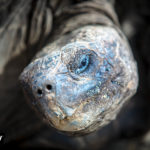
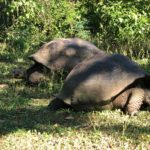
On our final day, we make the second land excursion to Santa Cruz. It’s by far the busiest island in the Galapagos with a population of around 12,000. We’re meant to go to the Darwin Research Station to see giant tortoises, but instead detour to Rancho el Manzanillo, a privately-owned farm where dozens of tortoises roam free. Ruly gives us a brief talk in the onsite restaurant about the tortoises’ ecology and history and guides us on a short walk before turning us loose to wander the paths and forested area in search of giant tortoises on our own.
I happen upon a pair munching quietly in the shade and settle in near a tree to watch them, remaining as unobtrusive as possible. Despite their size, they spook easily and do not care for close human contact. After about an hour, it’s time to head back to the boat and begin the journey back to San Cristobal, from where we’ll disembark the next day.
Details
With eight cabins, the Galapagos Master can accommodate 16 guests. Cruises are either seven or 10 nights; longer itineraries get two full days at each Darwin and Wolf Islands. You’ll want to be nitrox certified before you go, as there’s no training offered on board. Make sure you’re comfortable in potentially strong currents as well — bring an SMB and know how to use it.
How to get there:
To reach the Galapagos Master, you’ll initially fly into either Quito or Guayaquil; plan on an overnight in whichever city you choose the night before your flight on to San Cristobal. If you book your domestic flight directly with Master Liveaboards, a company representative will meet you at the airport before your flight to San Cristobal to walk you through the process. In Quito there’s a separate check-in area for the Galapagos where they’ll screen your bags and attach green zip-ties once they’re through. You’ll then proceed through security as usual.
On arrival in the Galapagos you’ll pay a $100 national park fee (in cash) before boat representatives whisk you away for the trip of your dreams.
When to go:
There’s no bad time of year to go to the Galapagos; it just depends on what you most want to see. The most popular time of year understandably is whale-shark season, from June through November. During this time divers can see up to a dozen whale sharks on one dive at Darwin’s Arch. It’s not impossible to see these giants at other times, however; I visited in April and saw them on three separate dives. This season brings cooler water conditions, so plan accordingly.
From December through May the water is warmer, typically from 78 to 82 F (25 to 27 C), and there are more mantas, and other rays, around Wolf and Darwin Islands. This is typically the best season to see the iconic “wall of hammerheads” at Wolf Island as well. I was there in May, however, and the water was slightly colder, topping out at 75 F (24 C) and cooler at depth. Although we didn’t see mantas, we did see whale sharks and tons of hammerheads.
The post The Greatest Hits of the Galapagos Islands appeared first on Scuba Diver Life.
from Scuba Diver Life https://ift.tt/2D2m9dP
No comments:
Post a Comment